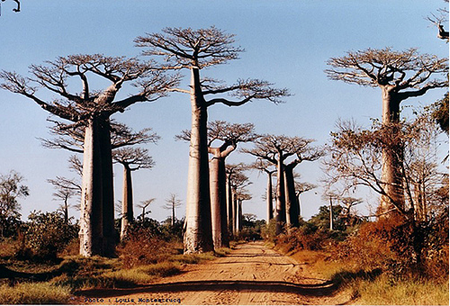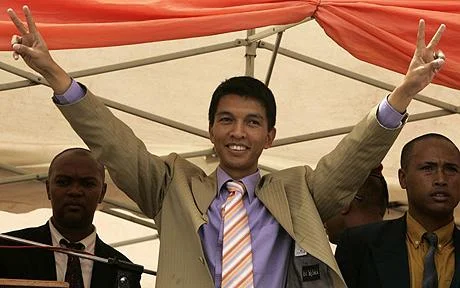Madagascar: Starving People, Dying Biodiversity, One Political Coup & Agro-Imperialism In Action
/Anne of Carversville is such a crazy place:Smart Sensuality Ralph Lauren fashion model anorexia versus Cultural Creatives starvation in Madagascar. Both topics are on today’s radar, finally answering the question: can a human head be bigger than one’s hips?
The fashion industry assures us that no thinking alpha brain truly believes that human beings have heads bigger than their hips.
It’s only fat mommies in need of a chill pill, who object to being sculpted to Ralph Lauren perfection in this way.
I ask you, is this UNICEF photo of a starving child in Madagascar another botched Photoshop job? Or is it the real deal, further proof of the aristocratic argument that you can never be too rich or too thin?
Perhaps Leona Helmsley was right when she said “Let them eat cake.” Pardon me, that was Marie Antoinette. Leona said: “Only the little people pay taxes.”
This big-headed human being is not a starry-eyed fashion model trying to skinny down for Lauren or Lagerfeld, but a real-life, dying child with no choice about what’s for lunch.
In Milan or Paris smart chicks say “No thanks, I’m only drinking water.”
In Madagascar, there isn’t any, writes the LA Times:
The sun exhausts the vaza: four journalists and a group of aid workers from UNICEF and the World Food Program. Scorpions bristle under rocks. There’s little shade.
A small Anjandobo child watches the vaza with their water bottles.
“I’m thirsty.”
“No water,” replies the child’s mother.
Her younger toddler chimes in. “I want to drink water.”
“No water,” the mother repeats, matter-of-fact.
Madagascar’s rainfall has decreased 10% in the last 50 years, and its temperature has risen 10%. — The World Bank
Madagascar the MovieWe’re writing about the real deal in Madagascar today, not some “keep the party goin’, get your groove on” kids movie.
Robyn Dixon, writing for the LA Times, puts a face on Madagascar, weaving the barren statistics of hunger in the country — 250,000 children under 5 have inadequate food in a total malnourished population of 1.5 million — with the wisdom of its inhabitants.
“I think the big God is unhappy. Young people are killing each other for nothing. They don’t respect the taboos. It never happened in the old days.”
Statistics and ancient sayings come to life now: the UN, World Bank, NGOs meet up with centuries-old customs and dusty, downtrodden, hugry, thirsty people.
Don’t forget Mother Nature. She’s center stage in this drama, perhaps the mother of all evil.
Correction.There’s plenty of evil in Madagscar and Disney can’t cure it.
Anne of Carversville weighs in now, supporting Dixon’s shocking drama with our own writing about Madagascar:
Route nationale Madagascar, 2006 via Fickr’s litutucApril 4, 2009
Madagascar and Beyond: Biodiversity Under Seige
I first learned about Madagascar last week, writing about vanilla as an aphrodisiac, a sinfully delicious sensual flavoring, produced as the fruit of two species of orchid plants.
Uninformed about Madagascar’s global role as a hub of biodiversity, I receive a quick education — not only about the current plight of vanilla growers — but the Madagascar’s center stage role in the world’s fight to save endangered species.
According to TIME magazine’s cover story The New Age of Extinction - Saving the World’s Endangered Species, some 90% of Madagascar’s plants and about 70% of its animals are endemic, or unique to the island.
“If we lose these animals on Madagascar, they’re gone forever,” says Russell Mittermeier, president of the wildlife group Conservation International (CI).
Scientists believe that Madagascar’s biodiversity makes it unique on the face of the earth, a special case situation of epic importance. With 80% of the original vegatation cut down in the last 1500 years, and with modern living accelerating the pace of wiping out one species in staggering numbers, vanilla production is only one of the country’s worries. more of original story with videos of Madagascar
August 24, 2009
Lemurs Hunted, then Served in Upscale Restaurants
Scarce Madagascar lemurs are being slaughtered for upscale dining tables.National Geographic reports that rare lemurs are being killed and eaten, as critical conservation efforts are abandoned since the ousting of Madagascar’s President Marc Ravalomanana. Support from the World Bank and the U.S. has dried up with the political unrest.
Less than a year ago Madagascar—home to the highest number of plant and animal species found nowhere else on Earth—was a different place.
The country “was on the verge of becoming a success story,” said lemur expert Russell Mittermeier, president of Conservation International. more of original story
More National Geographic: Lemur Forests Pillages by “Gangs” as Madagascar Reels
November 21, 2009
Keep reading and you’ll understand why global warming isn’t the only reason that Mother Nature has gone beserk in Madagascar. Granted, I am speculating here, with no proof of any unsaid inferences.
Madagascar has been mired in political crisis most of 2009.
- Andry Nirina Rajoelina, a Malagasy politician and media owner, dissolved Madagascar’s parliament, changed the high court judges and swore himself in as transitional head of state of Madagascar on March 21, 2009, having been installed in that position by the military at the end of a political crisis.
- Rajoelina dethroned president Marc Ravalomanana, president from 2002 to the coup.
- France’s AFP reports just three hours ago, that Emmanuel Rakotovahiny, a co-president from one of the four political movements has that all the rival parties are still working to form a government. We have a very big guy-crowd in this AFP report, all clamoring for the right to represent Mother Nature and her hungry people.
One of Madagascar’s presidents Andry RajoelinaEarlier this month, Madagascar’s current leader Andry Rajoelina, the president he toppled Marc Ravalomanana and two former presidents signed a power-sharing deal, although mediators admitted it was fragile.
The agreement saw Rajoelina retain his post, introduced two co-presidents, a prime minister, three vice prime ministers and 31 ministers to steer the country to elections in 2010. via AFP
Magadasar is (or was) the most biodiverse habitat on the planet, a rich land teaming with life capable of creating great harvests for the hungry.
OK. Now get ready for the clincher, and it’s not in the headlines. This weekend’s NYTimes magazine features an important story Is There Such a Thing as Agro-Imperialism?
I want to stay on point here, so I’ll ignore the details of the Saudis wanting to insure their food supply by establishing plantations in Mali, Senegal, Sudan and Ethiopia. Retelling the details, Dr. Robert Zeigler, an eminent American botanist according to the NYTimes, flew to Saudi Arabia in March for a consult on this incredible Saudi food initiative.
They laid out this incredible plan,” Zeigler recalled. He was flabbergasted, not only by the scale of the projects but also by the audacity of their setting. Africa, the world’s most famished continent, can’t currently feed itself, let alone foreign markets.
Read on or wait for me to pick it up tomorrow. In a nutmeg nutshell, food and land for cultivation represent the new global gold rush. The battle of global argicultural champions is preparing for battle and Wall Street’s onboard.
Is There Such a Thing as Agro-Imperialism? is an in-depth NYTimes article, and when it comes to Madagascar, the devil is in the details. Reading out loud to my friend, I couldn’t believe my eyes.
No wonder they have the interim president, two co-presidents, a prime minister, three vice prime ministers and 31 ministers to steer Madagascar to elections in 2010.
In November 2008 the Financial Times broke a story Daewoo to cultivate Madagascar land for free.
Daewoo Logistics of South Korea said it expected to pay nothing to farm maize and palm oil in an area of Madagascar half the size of Belgium, increasing concerns about the largest farmland investment of this kind.
The Indian Ocean island will simply gain employment opportunities from Daewoo’s 99-year lease of 1.3m hectares, officials at the company said. They emphasised that the aim of the investment was to boost Seoul’s food security.
“We want to plant corn there to ensure our food security. Food can be a weapon in this world,” said Hong Jong-wan, a manager at Daewoo. “We can either export the harvests to other countries or ship them back to Korea in case of a food crisis.”
Travail collaboratif à Madagascar / Collaborative work in Madagascar. Expo “Madagascar, carnet de route en multivision” - octobre 2009 - Saint-Martin-du-Var via Flickr’s REMY SAGLIER-DOUBLERAYDaewoo said it had agreed with Madagascar’s government that it could cultivate 1.3m hectares of farmland for free when it signed a memorandum of understanding in May. When the company signed the contract in July, it agreed to discuss costs with Madagascar. But Daewoo now believes it will have to pay nothing.
“It is totally undeveloped land which has been left untouched. And we will provide jobs for them by farming it, which is good for Madagascar,” said Mr Hong. The 1.3m hectares of leased land is almost half the African country’s current arable land of 2.5m hectares.
Daewoo Logistics had signed an agreement to take over about half of Madagascar’s arable land, paying nothing, with the intention of growing corn and palm oil for export. Popular protests broke out, helping to mobilize opposition to Madagascar’s already unpopular president, who was overthrown in a coup in March.
This look at the most biorich country in the world is now an ongoing story at Anne of Carversville, an incredible drama of all the forces at play in the world landing in this fertile crescent of a country. As in so many places in the world, humanitarian relief is on hold. And yes, we must cry out on behalf of the starving.
For the second time this month, I point to the menfolk, believing in my big, bleeding heart that men must stop worrying about women’s virtue in this turbulent, entangled world. We have question of right and wrong that are epic in proportion, and yet they do not make headlines.
Until today, I thought the worst thing happening in Madagascar was eating lemurs and destroying vital pieces of the world’s ecosystem. No offence my dear furry friends, but you’re just small potatoes in a most extraordinary global stew that’s brewing on the back stove.
If history is any guide in this transaction, the meal will be fully cooked and the Indians dead for we understand what’s happening in the world’s greatest land rush. Anne
More reading: Children starve in parched southern Madagascar LA Times
FACTBOX: Foreign forays into African farming Farmlandgrab.org







